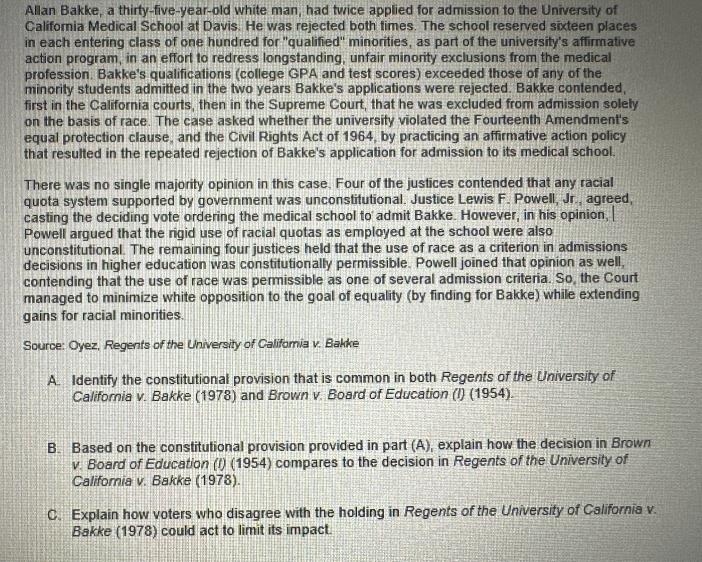Answered step by step
Verified Expert Solution
Question
1 Approved Answer
Allan Bakke, a thirty-five-year-old white man, had twice applied for admission to the University of California Medical School at Davis. He was rejected both

Allan Bakke, a thirty-five-year-old white man, had twice applied for admission to the University of California Medical School at Davis. He was rejected both times. The school reserved sixteen places in each entering class of one hundred for "qualified" minorities, as part of the university's affirmative action program, in an effort to redress longstanding, unfair minority exclusions from the medical profession. Bakke's qualifications (college GPA and test scores) exceeded those of any of the minority students admitted in the two years Bakke's applications were rejected. Bakke contended, first in the California courts, then in the Supreme Court, that he was excluded from admission solely on the basis of race. The case asked whether the university violated the Fourteenth Amendment's equal protection clause, and the Civil Rights Act of 1964, by practicing an affirmative action policy that resulted in the repeated rejection of Bakke's application for admission to its medical school. There was no single majority opinion in this case. Four of the justices contended that any racial quota system supported by government was unconstitutional. Justice Lewis F. Powell, Jr., agreed, casting the deciding vote ordering the medical school to admit Bakke. However, in his opinion, Powell argued that the rigid use of racial quotas as employed at the school were also unconstitutional. The remaining four justices held that the use of race as a criterion in admissions decisions in higher education was constitutionally permissible. Powell joined that opinion as well, contending that the use of race was permissible as one of several admission criteria. So, the Court managed to minimize white opposition to the goal of equality (by finding for Bakke) while extending gains for racial minorities. Source: Oyez, Regents of the University of California v. Bakke A. Identify the constitutional provision that is common in both Regents of the University of California v. Bakke (1978) and Brown v. Board of Education (1) (1954). B. Based on the constitutional provision provided in part (A), explain how the decision in Brown v. Board of Education (1) (1954) compares to the decision in Regents of the University of California v. Bakke (1978). C. Explain how voters who disagree with the holding in Regents of the University of California v. Bakke (1978) could act to limit its impact.
Step by Step Solution
There are 3 Steps involved in it
Step: 1
A The constitutional provision common in both Regents of the University of California v Bakke 1978 and Brown v Board of Education I 1954 is the Fourte...
Get Instant Access to Expert-Tailored Solutions
See step-by-step solutions with expert insights and AI powered tools for academic success
Step: 2

Step: 3

Ace Your Homework with AI
Get the answers you need in no time with our AI-driven, step-by-step assistance
Get Started


